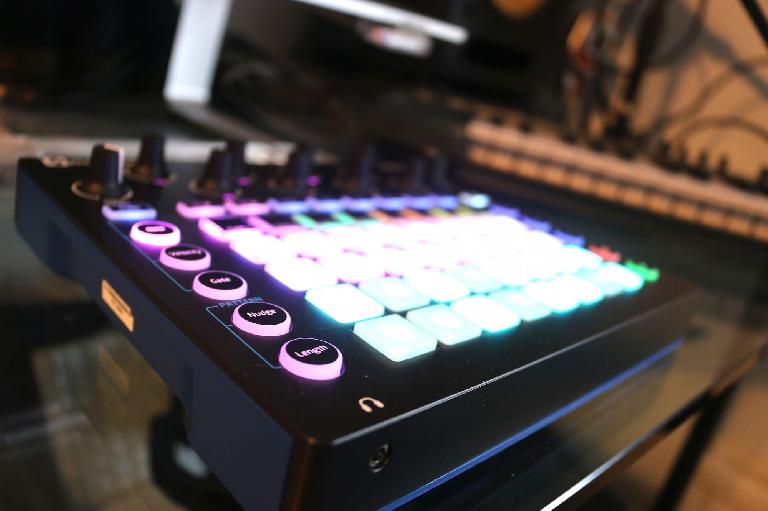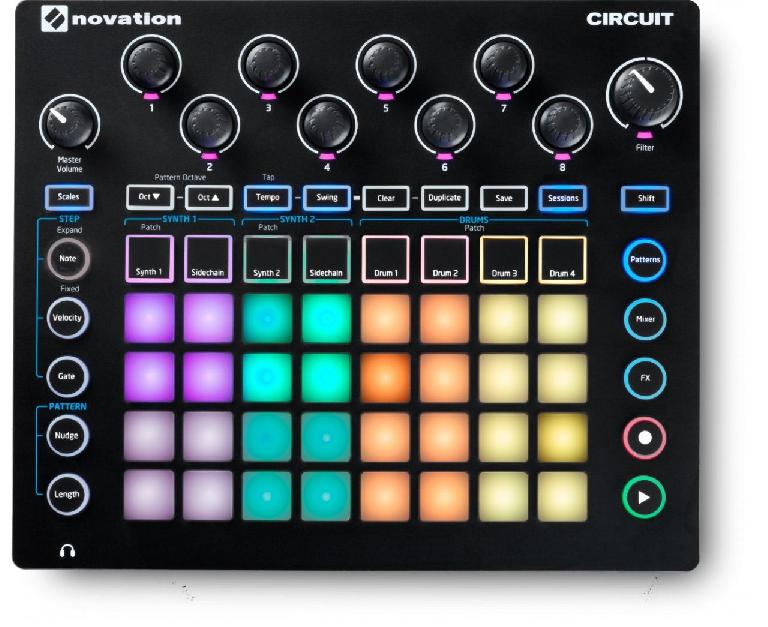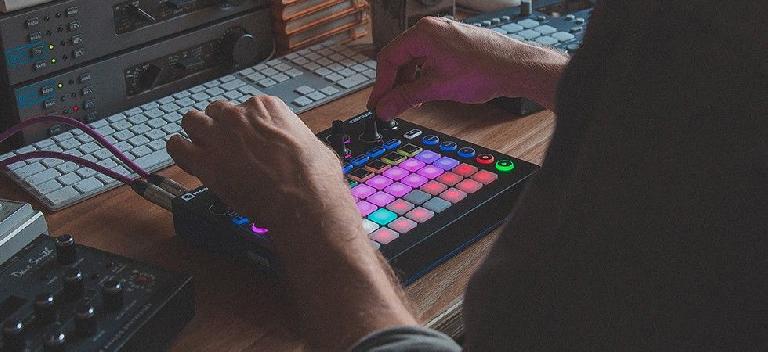Novation Circuit In-Depth Video Review
Hollin Jones on Oct 05, 2015 in | 0 comments
When I started making music as a kid in the early 1990s, Novation was one of the companies whose products I used to gaze reverently at in music stores. I couldn’t afford them—or much else for that matter—but they looked impossibly cool. The A-Station, Bass Station and Supernova were all things I wished I could own in the '90s, but if you’d told me then how the music technology landscape would look in 2015, I’d have said you were mad. A product like Circuit would have seemed beyond space age.
At first glance you might think Circuit is a controller, because it does look like one: cues have been taken from Novation’s much-loved Launchpad for sure. While it can do MIDI control, that’s not its main focus. In fact, it’s a standalone groovebox with two polysynths based on the company’s Nova heritage and a four-part drum machine. That’s all controlled with 32 backlit and color-shifting velocity sensitive pads, 28 backlit buttons and 8 continuous knobs with RGB color indicators.
Standing Alone
The driving force behind Circuit is the idea that it should be able to operate totally independently of a computer. Starting an idea, says Novation, can be the hardest part of the creative process. I’d tend to agree with the notion that being faced with thousands of virtual instrument presets on a computer screen can elicit as much apathy as excitement. Even having to fire up a DAW, make sure the MIDI keyboard is plugged in and locate a sound is enough to sometimes make me forget the idea I originally had. Circuit is supposed to get around all that. But how does it do it?
To understand just how standalone Circuit is, you need to start by looking at the hardware. It’s small—around the size of an iPad—but slightly thicker and heavier than you probably expect, though still not particularly heavy even with the batteries loaded. Oh yeah—it can run on 6xAA batteries. And it has a speaker mounted on the underside. There’s a power supply included too, though USB power isn’t supported. On the front edge is a mini headphone output (cue lots of people looking online for big to small headphone adaptors) and on the right edge is a lock port and a door for the battery compartment.
The portability is incredible and you are legitimately free from wires if you choose to be, which is very liberating... I actually took it to the park and used it: it’s that portable.
The rear panel contains the power switch, PSU socket and USB for connecting to a Mac or PC. There are two mini MIDI sockets, and breakout cables are supplied so you can hook it up to MIDI kit without needing to go via a computer, and there are full size ¼ inch jack sockets for left and right audio outputs. The underside is heavily rubberized and definitely won’t slide around. Novation has called it right in making Circuit able to power off batteries and giving it a built-in speaker, as well as the more conventional alternatives. Even though the speaker is never going to sound as big as headphones, it’s decent, loud and it’s good to know you can just pick it up and take literally nothing else, and still make patterns. I actually took it to the park and used it: it’s that portable.
Nova Synth Brain
Circuit is self-contained and at its heart are two polysynths and a four-part drum machine, and there’s 6-part polyphony per synth. Pressing an instrument selects it, and shift + pressing turns the pads into a patch selector. There are 64 synth and 64 drum patches and you’re encouraged to flip between these to modify your sounds. With a part selected, the eight dials along the top become modifiers. Although there are no readouts, the functions are divided so that for example macros 1 and 2 change synth oscillators, 3 and 4 adjust envelope parameters, 5 and 6 do filters and 7 and 8 modulation and effects. For the drums, they affect different but not dissimilar kinds of things. There’s a big fat filter knob at the top right that affects the whole output. Turn it one way for high pass and the other way for low pass.
There were times when I wished I could have just seen a number displayed rather than relying on color coded lights.
So tweaking sounds is actually very easy, and tremendous fun to boot. There’s no LED readout and this is probably because they want to encourage more organic experimentation rather than trying to stop the dials on a specific numerical value. For the most part that’s fine, though in use there were times when I wished I could have just seen a number displayed rather than relying on color coded lights. The color coding works really well, but it’s being asked to do literally all the visual feedback, which for some tasks is more work to keep track of than for others. Sometimes when possible, it actually feeds back by drawing numbers using the lights on the pads. This happens when setting master BPM for example, and it’s great. But most of the time the pads are in use for other things.

Padding Around
Speaking of the pads, they have a ton of functions. For programming parts they split into two rows. For the synths, the top two rows are notes and the bottom two show the position of the sequence. For the drums, the rows represent two drum sounds, typically kick and snare, and open and closed hats. Since pitch isn’t an issue, the drum view shows only sequence. In synth view, you can use the Note Expand shortcut to spread the notes over the entire pad view and get better playing control, such as for playing chords. You can also switch scales and the pads will lock to a scale, making it impossible to play a wrong note.
You can record in step or regular playback mode, though most people will prefer the latter as it’s much more intuitive. Velocity and gate (note length) can be tweaked for any given step by holding the step and punching in a value on a horizontal “meter” using the pads, and there’s even sidechain available for the two synths via dedicated buttons, with presets that make the synth sounds duck in relation to the kick drum. If it wasn’t already crystal clear that this is a box for making EDM, there’s the hammer blow.
There are onboard effects: 16 delays and 8 reverbs, and each sound can have its effect send level set individually. Remarkably, automation is supported both in the instruments and the effects.
Hit the Mixer button and you can easily mute any part, and the eight dials become level controls, helpfully color-linked for easy reference. There are onboard effects too: 16 delays and 8 reverbs, and each sound can have its effect send level set individually. Remarkably, automation is supported both in the instruments and the effects. With record active, tweak a synth macro dial or an effect send and that movement gets recorded. Just make sure to stop recording before it overdubs itself. This is really great to use and expands the creative capabilities of Circuit hugely. Want to add a wobble to the third snare hit, a filter sweep to a synth note and a load of reverb to a couple of cymbals? No problem. It makes it much more interesting than just using static sounds.

Making Patterns
Recording patterns is easy and notes are auto-quantized, as is automation. You can edit tempo and also add swing, as well as nudging notes, changing pattern length, scales and octaves. Copying and pasting is possible using the Duplicate command and you get a total of 32 Sessions (chains of patterns, or songs in other words), each containing 6 tracks, with 8 patterns per track. Holding the Patterns button shows you which patterns are active and you can change these in real time, with Circuit waiting for the next bar before jumping so your timing is accurate. It’s down to you to remember what pattern is in which slot though, since there’s no screen to tell you. Nonetheless, provided you can remember, it’s a fun way to perform live and you can always jump back into the other views to edit patterns or to tweak synth sounds and effects live.
Who Is It For?
Circuit is an immensely cool product. It’s for electronic music, so if that’s not your thing I’m amazed you’ve read this far. But it IS a lot of peoples’ thing, and those people will love it. The portability is incredible and you are legitimately free from wires if you choose to be, which is very liberating. It has a groove and a feel to it that’s hard to explain, but when you try one out you’ll get it. It just kind of vibes really nicely. The sounds are great but the ability to tweak them organically, add effects, automate all that and stick some sidechain on the synths means this little box can really pump and scream when you make it.
Circuit has a groove and a feel to it that’s hard to explain, but when you try one out you’ll get it. It just kind of vibes really nicely.
There is by necessity some shift + pushing of buttons to access alternate functions, but on the whole the layout works really well. Special mention must go to the clever use of the pad lighting for far more than just programming. There are occasions when a small three-digit LED screen would probably improve visual feedback, and I don’t think that including one would have been any kind of big compromise. But for the really important stuff, the colors do the job well.
Going Further?
Your patterns can be connected to external MIDI gear without using a computer, but Novation is in the process of developing software to go with it as well. (It comes with Ableton Live Lite 9). Although this is still at the planning stage, things under consideration apparently include synth editing, uploading drum samples and backing up projects. At present it can send a fair amount of MIDI data like notes and automation out over USB to a computer, though automation isn’t sent via the hardware MIDI ports due to bandwidth restrictions. It also works as a generic USB controller so you can map hardware controls using MIDI learn in your own software.
As things stand, for a fun, powerful and amazingly portable pattern creation tool and groovebox, they don’t come any better than this.
The ability to output audio loops or whole sessions to the computer as sound might be a cool addition, although arguably could go against the spirit of Circuit as a hands-on, standalone device. Being able to output your patterns as audio stems over USB is a pretty tantalizing prospect, and likely possible via software. Time will tell how Novation decides that one. As things stand, for a fun, powerful and amazingly portable pattern creation tool and groovebox, they don’t come any better than this.
Watch our video review and overview for Novation Circuit here:
Price: £249.99 GBP inc VAT / $329.99 USD ex Tax
Pros: The most portable thing ever. Battery power and built-in speaker. Excellent synth and drum sounds. Insanely tweakable. Record patterns and automation. Clever light-led workflow. Makes great use of the 32 pads. Sounds fatter than hell. Connect to MIDI gear. True computer-free operation. Hugely fun and creative.
Cons: There are a few cases where keeping track of everything using colored lights can be a bit more work. Software not available—yet. Needs more juice than a USB port can supply. Output of stems over USB would be amazing.




 © 2024 Ask.Audio
A NonLinear Educating Company
© 2024 Ask.Audio
A NonLinear Educating Company
Discussion
Want to join the discussion?
Create an account or login to get started!